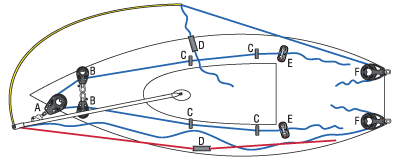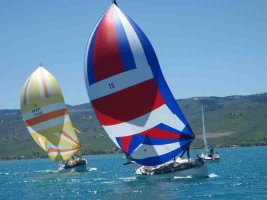G'day like minded sailors,
I have recently purchased a second hand spinnaker - 0.75 oz symetrical I =47', for Merrimist 1986 E38-200. Now I am in the process of getting the pole and rigging sorted and would like to ask those of you who have experiance setting and use of extendable Forespar (old achool) pole.
I usually find myself sailing shorthanded so I would like to keep things simple yet safe and functional.
1. Pole fore-guy, used yes or no? If so, where attached to boat? For ex. onto bail at anchor roller or elsewhere? Control back to cockpit or on deck and made off.
2. Working Aftguy. Is this used or is the lazy sheet used for this purpose? Smaller boats I have not used an aftguy.
3. Port and stbd sheets used, lazy and working, are two seperate aft guy lines used, working and lazy?
4. Any words of advice and tips or tricks for the set up and use are all appreciated.
Please describe clearly or forward pics if possible of set up.
Cheerio.
Hammy in sunny Bermuda
Merrimust E38-200.
I have recently purchased a second hand spinnaker - 0.75 oz symetrical I =47', for Merrimist 1986 E38-200. Now I am in the process of getting the pole and rigging sorted and would like to ask those of you who have experiance setting and use of extendable Forespar (old achool) pole.
I usually find myself sailing shorthanded so I would like to keep things simple yet safe and functional.
1. Pole fore-guy, used yes or no? If so, where attached to boat? For ex. onto bail at anchor roller or elsewhere? Control back to cockpit or on deck and made off.
2. Working Aftguy. Is this used or is the lazy sheet used for this purpose? Smaller boats I have not used an aftguy.
3. Port and stbd sheets used, lazy and working, are two seperate aft guy lines used, working and lazy?
4. Any words of advice and tips or tricks for the set up and use are all appreciated.
Please describe clearly or forward pics if possible of set up.
Cheerio.
Hammy in sunny Bermuda
Merrimust E38-200.




